BERKSHIRE MOUNTAINS, Massachusetts –For the 37th year, members and friends of the EarthSpirit Community gathered this past week for the Rites of Spring. Like many Pagan festivals, this is a private affair for which advance registration is required. Participants are expected to aid in building a temporary community in the woods, wherein the focal point is the very maypole that represents the season in this, and many other, Pagan traditions. Radiating outward from that beribboned symbol of fertility Pagans and friends circled, danced, learned, laughed, drank in the gifts of the Earth and returned a fair portion to the mountain which plays host year in an year out.
Long before that stout log was hoisted towards the sky, tireless volunteers began weaving an invisible web which would define and support the weeklong festival. The strands are unseen because they have been spun and woven again and again over the years, but the web created is a strong one. Upon arriving at my first Rites of Spring, that web surrounded and supported me every step of the way. Clear signage guided my faithful car, Bucephalus, and I to the registration area, and if I got turned around, there was always someone to set me back on the path towards the gate.
After my ritual entry, I was smoothly led through a registration process that practically didn’t need my participation. The registrars confirmed my arrival, attached a wrist band to identify my meal plan, verified that I was planning on using a tent rather than staying in a cabin, and directed me to my selected tent site, as well as to the permanent parking area for when I was done unloading. An unbreakable, invisible infrastructure kept me on task and oriented, ensuring that I would have housing and food taken care of no matter how gobsmacked I became.
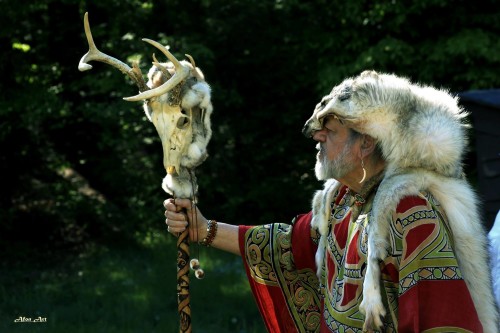
Andras Corban Arthen (courtesy Megan Walker, Afon Art)
The entire site had been transformed by a core group of village builders, who arrive some days ahead of the main body of attendees, and who numbered about 400 this year. Andras Corban Arthen, who coordinates the annual gathering with his wife, Deirdre Pulgram Arthen, recalled that in the first year, Rites of Spring was a learning experience. He said, “It quickly became apparent that rituals designed for a living room don’t work for a hundred people,” which is how many attended that first festival.
While as many as 700 have attended some years, the traditions of the EarthSpirit Community — and even the modern Pagan community — were just being formed at that time. “I had the only drum there, and no one was interested in having a fire,” Corban Arthen admits as part of recounting the history of the organization. When a fire was finally lit and some started to dance, “others were almost repulsed,” he said, because “that’s not in the book of shadows.”
Fire plays a core part in Rites of Spring each year, being kindled as part of the first ritual and providing space for personal and group sacred work throughout the week. The web of support is particularly vibrant in the fire shrine: food donations are actively sought for the drummers and dancers, water is copious, and safety protocols are always in place, but never noticeable unless needed. Want to dance into trance from sunset until sunrise? Rest assured trance spotters will be aware of you, even if you’re not aware of your own surroundings. Providing someone the space to walk their own path, but ensuring they remain hydrated and safe, is one of the many gifts found on this community’s web.
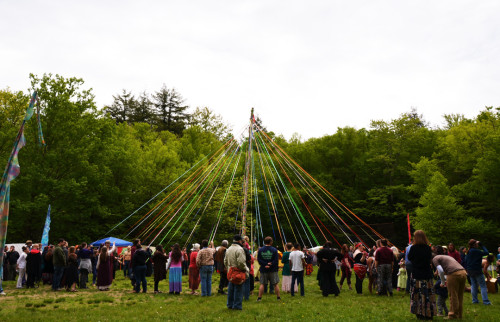
Dancing the maypole [Courtesy EarthSpirit Community]
That’s partly because the words and tunes are easy to learn, and partly because so many people attend again and again. About 20% of the attendees this year were newcomers, which Pulgram Arthen said is similar to past years. However, it was not difficult to find oneself in conversation with someone who had attended 20 or 30 prior Rites of Spring, and even a nine-year-old who had technically been to ten of them.
The age range this year ran from three babies still in bellies up to 73 years of age, and there were spaces and places for all. Once the ribbons adored the maypole, the depth of this community was given face as people approached it and announced milestones from the prior year: births and deaths, graduations and jobs, joys and sorrows. Like so many traditions at this festival, the process of sharing allowed people space for their news, but was efficient enough that the energy did not lag.
Keeping hundreds of Pagans occupied from Wednesday until Monday, particularly when they are so diverse in their ages and interests, was another opportunity to deepen the web of community. This multi-day event is a time when affinity groups, fostered by EarthSpirit, are able to meet and explore common interests. The daily schedule reserved a slot for these groups alone. For example, this year’s scheduled included a slot for participants 50 and over; one for those who have studied Faery Seership; and another for those exploring the role of queer energy in Paganism. For others, this time was an opportunity to explore nature or spend time connecting with old friends. Overall, the daily schedule was designed to provide space for magical moments that make a festival come alive in one’s memories, be it over a game of cards or a quiet conversation shared under the stars.
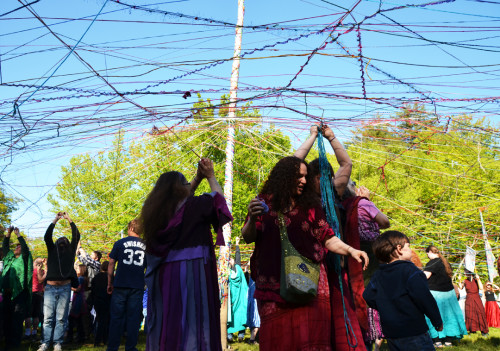
Weaving the web [Courtesy EarthSpirit Community]
Other classes targeted specific demographics, such as the Vulva Dialogues and several aimed at the younger generation of festival-goers. The Wilderness Survival intensive, for 9-15-year-olds, may have generated the most adult envy; youngsters learned about tracking, fire-building, camouflage, and spent the night in shelters they built themselves.
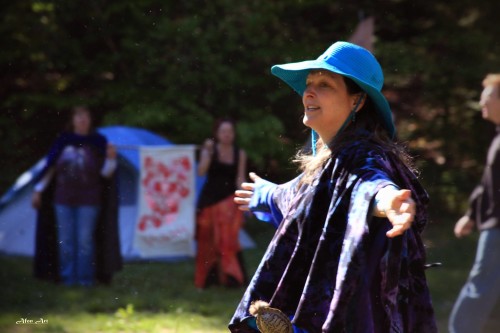
Deirdre Pulgram Arthen [Courtesy Megan Walker, Afon Art]
Part of the tradition is for pieces to go home as talismans, or materials for creating something new. Two such items appeared in this year’s auction, and fetched handsome prices. The auction is another annual piece of the festival, with proceeds this year going towards sending a delegation to A Parliament of World’s Religions, and to helping to upgrade EarthSpirit’s web presence.
In addition to an amazing assortment of hand-crafted items, a number of community members put themselves on the block to be “serving wenches” of any gender for the sumptuous feast. This celebratory spread, open to all participants whether they paid for a meal plan or not, is served buffet style. Winning a server at auction means more time to spend building community, and less time on line filling one’s plate.
As was the case frequently during the week, the atmosphere of the feast was livened by Brizeus, the pipe-and-drum band which is contracted to make everything more awesome. At any time, one could be surprised by bagpipes rolling across the site’s lake, or find oneself joining in a sing-along of Beatles and Floyd played on guitar.
Within this web of music, ritual, workshop, and quiet space, there was somehow room more. Late nights at Rites featured a number of musicians, as well as DJ dance parties and karaoke blow-outs. Professional-class storytelling and fire spinning rounded out the entertainment options. Lovers of ritual could choose a Heathen blot, ancestor devotionals, Quaker silent worship, labyrinth walking, and several others focusing on various magical and religious paths. Workshops numbered in the dozens, not including the intensives already noted. There was even an opportunity for Pagans in recovery to join in 12-step meetings. The web was strong enough to allow everyone to be as busy as a bee, as quiet as a mouse, or to change gears at a moment’s notice.
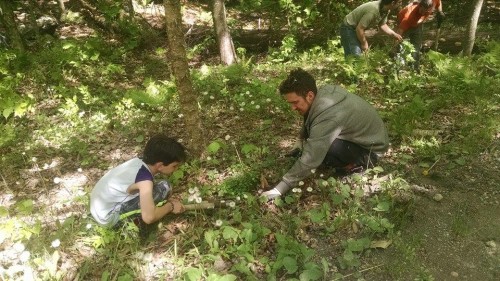
Rooting out invasive plants. [Courtesy EarthSpirit Community]
The transition back to everyday life can be a hard one, which is probably why it can take so long to say good-bye and hit the road. EarthSpirit has rituals to support this work, as well. Monday morning, a group of visitors sang a-maying songs throughout the camp, announcing the it was time to take down and pack up. When the community gathered one last time around the bewebbed maypole, the many people who helped to make the festival happen came forth to be acknowledged: not just the teachers and village builders and kitchen crew, but the newcomers and children and others who rounded out this temporary community were cheered.
Taking down the web was, of course, accompanied by the song “Carry it Home,” a perfect choice to help keep the magic of this time and place in one’s heart. And while most attendees sang their tearful partings as they processed back through the gate, their cars were being quietly moved around so that vehicles which had been packed like sardines were now all accessible for a quick load and leave. Even after the physical web had been taken down, the strands of support just made even those final mundane tasks a whole lot easier.
The Wild Hunt is not responsible for links to external content.
To join a conversation on this post:
Visit our The Wild Hunt subreddit! Point your favorite browser to https://www.reddit.com/r/The_Wild_Hunt_News/, then click “JOIN”. Make sure to click the bell, too, to be notified of new articles posted to our subreddit.
It was great to have you with us this year Terence, and it’s good to hear that the intentional web we connect to at Rites of Spring is so visible – even for a first-timer. Glad you are a part of it now!
What a great article! It conveys the multi-layered energies of the gathering so clearly . as wonderful to welcome you into the web!
Thank you for this! I had an amazing Rites, just like every year, and I am continually impressed by the love and support of this community. All the people that come together to build the space and all the participants who help the space come alive fill my heart with memories that we create together. Thank you for this beautiful reflection of this space that I love so much!
I was eagerly awaiting this article, so curious to see what Terence would experience at his first Rites of Spring. It was a fabulous Rites for me, and he captured so much of the essence of what makes it fabulous. The people, the mountain, the songs and shared talents and oh the great food. As a long time attendee it felt great to read about “my” experience; connecting with old friends, making new ones, laughing (a lot) and yes, crying some too. And it feels great to know that “my” experience is a shared experience, unique of course, in some ways, but mirrored in the faces of others.
Wish I could have been there, but May has too many prior $$ obligations for me. One of these years….
WOW… what a great article! It was amazing to stand across the circle from you at The Challenge put on by Brotherhood of the Stag and Wolf, and I hope to call you Brother as we continue our paths.